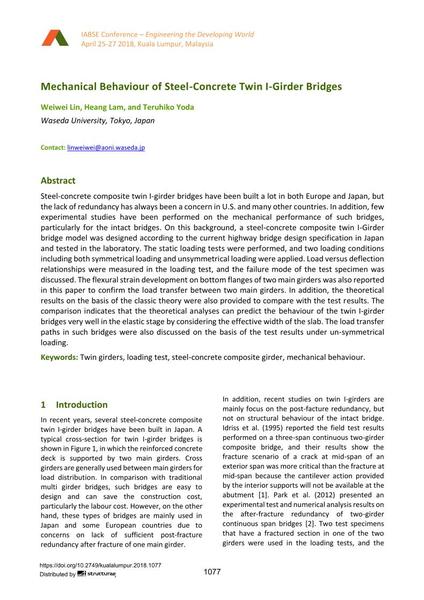Mechanical Behaviour of Steel-Concrete Twin I-Girder Bridges

|
|
|||||||||||
Détails bibliographiques
| Auteur(s): |
Weiwei Lin
(Waseda University, Tokyo, Japan)
Heang Lam (Waseda University, Tokyo, Japan) Teruhiko Yoda (Waseda University, Tokyo, Japan) |
||||
|---|---|---|---|---|---|
| Médium: | papier de conférence | ||||
| Langue(s): | anglais | ||||
| Conférence: | IABSE Conference: Engineering the Developing World, Kuala Lumpur, Malaysia, 25-27 April 2018 | ||||
| Publié dans: | IABSE Conference Kuala Lumpur 2018 | ||||
|
|||||
| Page(s): | 1077-1084 | ||||
| Nombre total de pages (du PDF): | 8 | ||||
| DOI: | 10.2749/kualalumpur.2018.1077 | ||||
| Abstrait: |
Steel-concrete composite twin I-girder bridges have been built a lot in both Europe and Japan, but the lack of redundancy has always been a concern in U.S. and many other countries. In addition, few experimental studies have been performed on the mechanical performance of such bridges, particularly for the intact bridges. On this background, a steel-concrete composite twin I-Girder bridge model was designed according to the current highway bridge design specification in Japan and tested in the laboratory. The static loading tests were performed, and two loading conditions including both symmetrical loading and unsymmetrical loading were applied. Load versus deflection relationships were measured in the loading test, and the failure mode of the test specimen was discussed. The flexural strain development on bottom flanges of two main girders was also reported in this paper to confirm the load transfer between two main girders. In addition, the theoretical results on the basis of the classic theory were also provided to compare with the test results. The comparison indicates that the theoretical analyses can predict the behaviour of the twin I-girder bridges very well in the elastic stage by considering the effective width of the slab. The load transfer paths in such bridges were also discussed on the basis of the test results under un-symmetrical loading. |
||||
